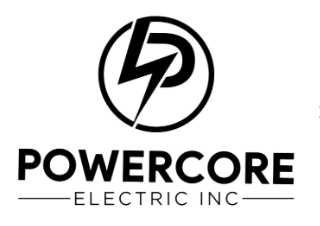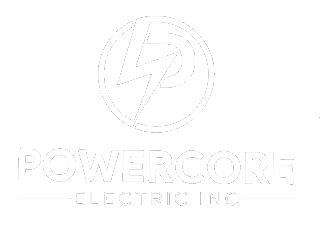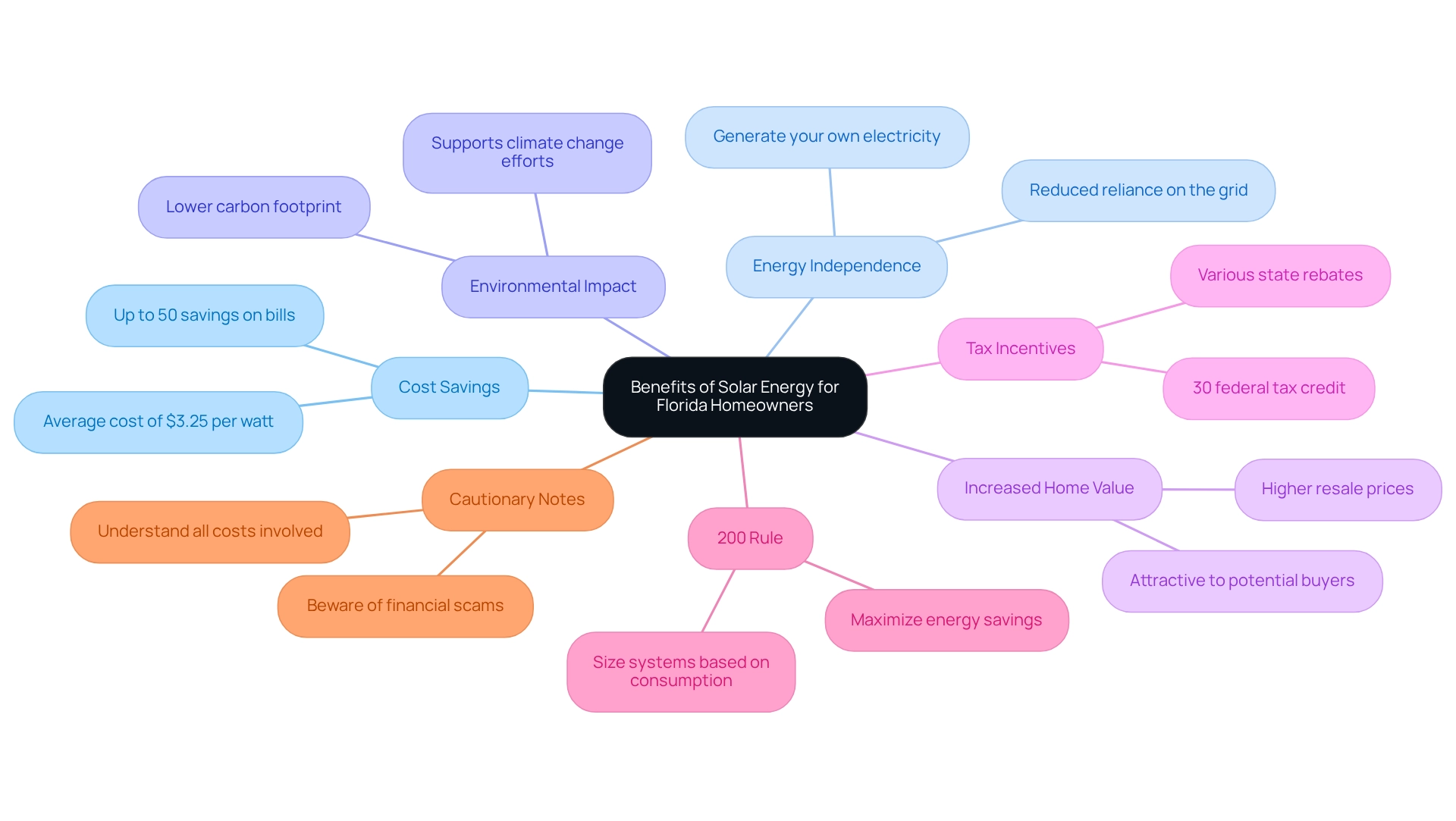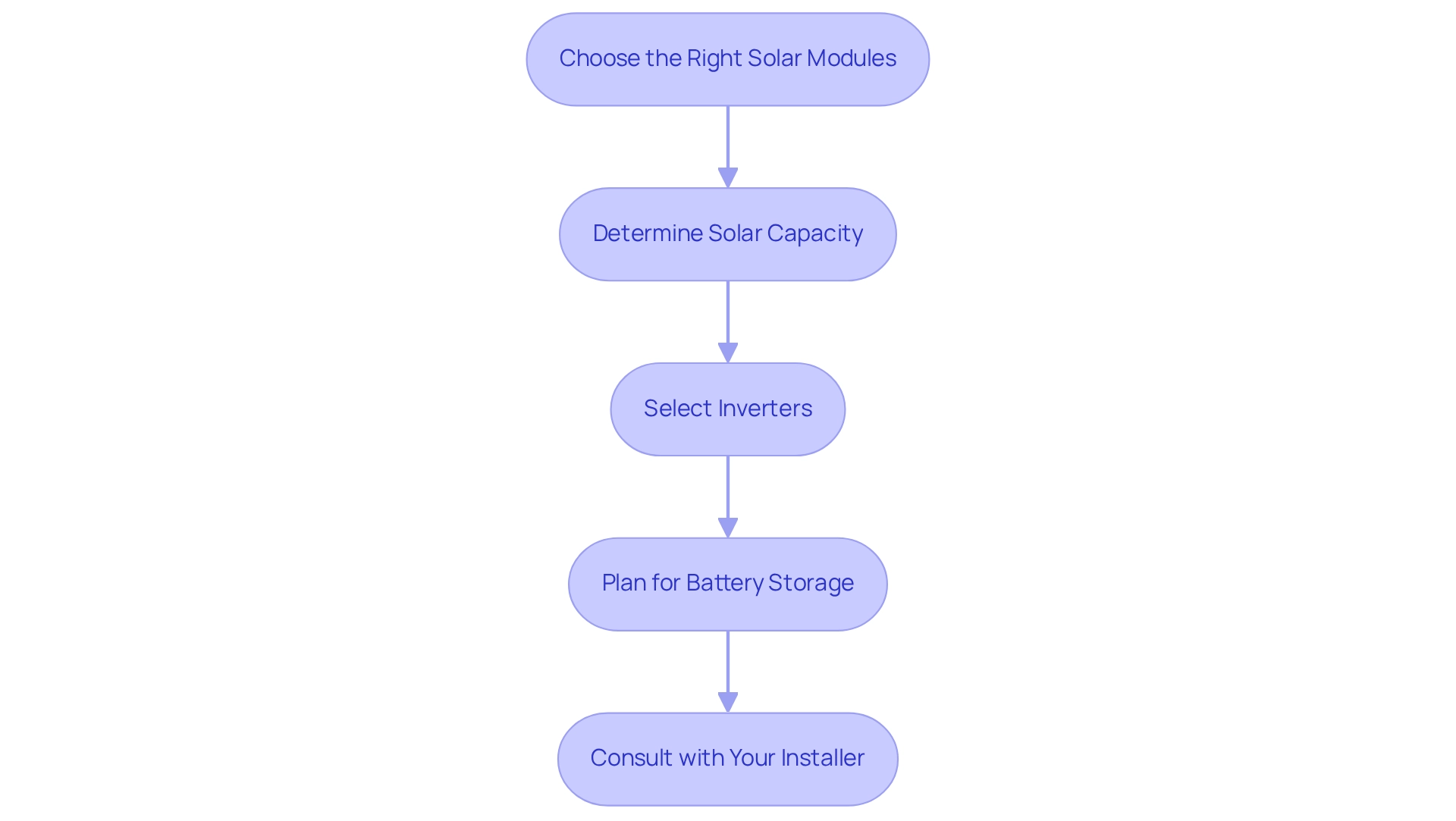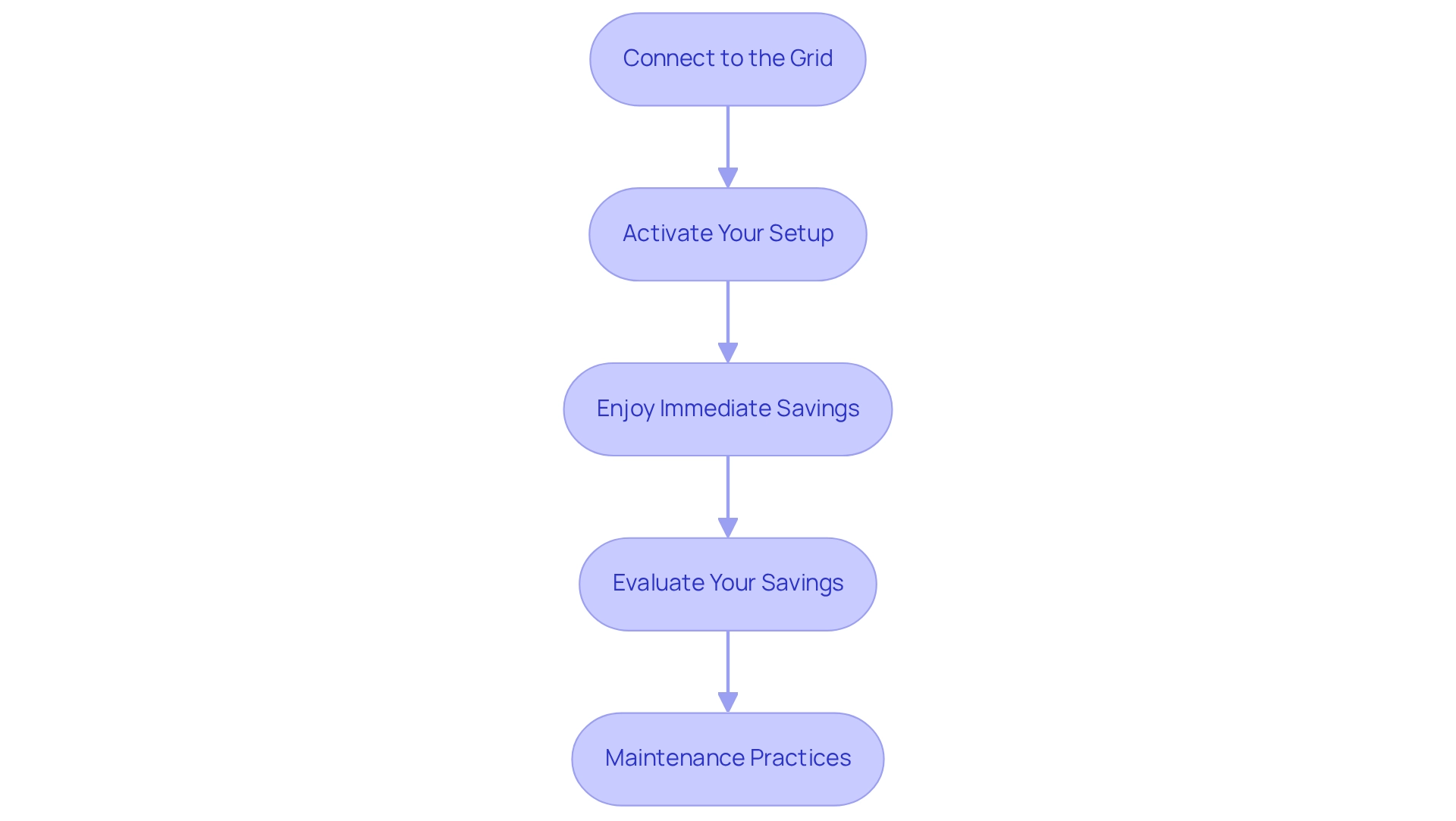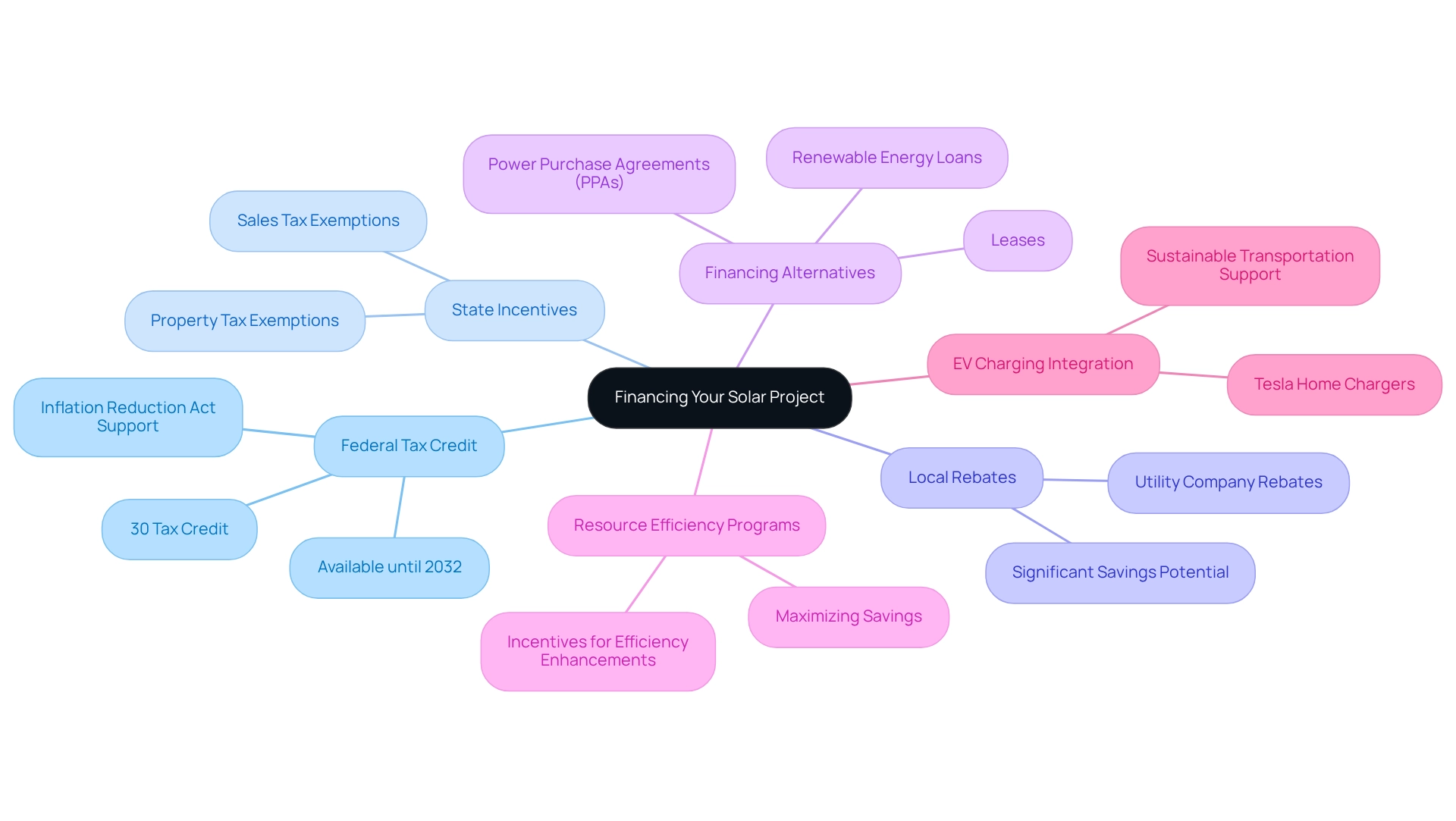Overview
Homeowners in Florida often find themselves grappling with rising energy bills, and the thought of going solar can feel overwhelming. However, by following a structured process that includes:
- Assessing your home’s solar potential
- Designing a custom system
- Ensuring professional installation
You can transform your energy experience. This article outlines these steps, emphasizing the financial benefits, environmental impact, and available incentives that make solar energy not just a viable option, but an attractive solution for reducing energy costs and enhancing sustainability.
We understand that making the switch to solar energy can seem daunting, but the rewards are significant. Imagine the freedom of energy independence, where you can take control of your energy bills and contribute positively to the environment. With the right support, transitioning to solar can be a smooth journey. Together, we can explore how solar energy can benefit you and your family, offering both peace of mind and a brighter future.
Let’s work towards making your home more sustainable and energy-efficient. By embracing solar energy, you’re not just investing in your home; you’re investing in a healthier planet for future generations. Reach out today to learn more about how we can support you in this exciting transition.
Introduction
In a state blessed with abundant sunshine, we understand that many Florida homeowners are concerned about rising energy bills and the impact on their budgets.
Fortunately, you are uniquely positioned to harness the power of solar energy, unlocking a multitude of benefits that extend beyond mere cost savings. Imagine significant reductions in your electricity bills, enhanced property values, and a commitment to environmental sustainability—these advantages of going solar are not just compelling; they can transform your home and lifestyle.
As the world shifts towards greener energy solutions, it’s common to feel overwhelmed by the options available. Navigating the solar landscape—from assessing your home’s potential to exploring financing options—becomes crucial for making an informed investment.
Together, we can illuminate the essential steps and considerations for homeowners eager to embrace solar energy, guiding you towards a more sustainable and economically sound future.
Understanding Solar Energy: Benefits for Florida Homeowners
Homeowners in Florida, we understand that can be a significant concern. Thankfully, solar power presents a wonderful opportunity to alleviate these worries, especially in a state blessed with abundant sunshine. Let’s explore some of the key advantages of going solar in Florida:
- Cost Savings: Imagine significantly reducing your electricity expenses by harnessing renewable power. Many residents report savings of up to 50% on their monthly energy bills, making solar energy a financially sound choice. The average cost of installing a photovoltaic system in Florida is around $3.25 per watt before interest, offering a clear financial perspective for those considering this transition. Plus, various financing options and government programs are available, making the journey to solar even more affordable.
- Energy Independence: By installing photovoltaic panels, you can generate your own electricity, reducing your reliance on the grid. This independence not only shields you from the unpredictable nature of utility costs but also allows for more manageable budgeting.
- Environmental Impact: Transitioning to solar energy significantly lowers your carbon footprint, contributing to a cleaner environment and playing a crucial role in the fight against climate change. This shift not only benefits you but also supports broader environmental goals that we all care about.
- Increased Home Value: Homes equipped with photovoltaic panels often see an increase in market value, making them more appealing to potential buyers and providing a solid return on investment. Research shows that homes with solar systems can be sold for higher prices than those without, making this a wise financial choice.
- Tax Incentives: As a Florida homeowner, you can take advantage of various tax credits and rebates, including a federal tax credit that allows you to deduct 30% of your installation costs from your federal tax bill. These incentives can significantly reduce the overall cost of your renewable energy installation, promoting adoption and making it more accessible.
- Understanding the 200% Rule: It’s also important to be aware of the 200% Rule, which allows you to size your energy systems based on your consumption, maximizing your energy savings and efficiency.
However, we also want you to be cautious of potential pitfalls. There have been instances of financial scams involving renewable energy that advertise ‘free panels’ through misleading promotions, leading to hidden charges and fees after agreements are signed. It’s essential to understand all costs associated with photovoltaic installations and to work with reputable companies like Powercore Electric.
As Joe Forest, a Florida homeowner, shares, ‘So far I see a huge reduction in my TECO bill,’ which highlights the real benefits of renewable power. This sentiment resonates with many who have made the switch, emphasizing the long-term savings and environmental advantages.
These compelling advantages underscore the importance of exploring renewable energy options, particularly how to go solar in Florida, as a viable choice for homeowners looking to enhance their energy efficiency and sustainability. Together, we can work towards a brighter, more sustainable future.
Step 1: Assessing Your Home’s Solar Potential
Before setting up photovoltaic modules, it’s essential to evaluate your residence’s sunlight potential. We understand that navigating energy costs can be overwhelming, so here’s a step-by-step guide to help you through the process with care and clarity:
- Assess Roof Direction: For optimal sunlight exposure, photovoltaic systems should ideally face south. Take a moment to assess your roof’s angle and orientation to ensure it aligns with this recommendation. In Florida, if you go solar, proper roof orientation can significantly influence the efficiency of photovoltaic systems, making this step particularly important for your energy independence.
- Check for Shading: It’s common to feel concerned about trees, buildings, or other structures that may cast shadows on your roof during peak sunlight hours. Identifying these potential obstructions is crucial. Using instruments such as pathfinders can assist in examining shading patterns efficiently, ensuring you make the most of your solar investment.
- Inspect Roof Condition: Ensuring your roof is structurally sound and capable of supporting the weight of photovoltaic panels is vital. If repairs are needed, addressing these issues prior to installation can prevent complications later, giving you peace of mind as you move forward.
- Analyze Energy Consumption: Reviewing your past electricity bills can provide valuable insights into your energy usage patterns. This information is crucial for deciding the suitable dimensions of the energy array you will require. Remember, energy shoppers who obtain quotes on EnergySage pay 20% less for their energy solutions, so consider seeking multiple quotes during your evaluation process to find the best fit for your needs.
- Consult a Professional: Engaging with an installation expert can be a reassuring step. They can conduct a thorough assessment of your property, providing tailored insights and recommendations specific to your situation. As James Elston, a leading boiler replacement and heating specialist, remarks, “There are numerous online applications and monitoring tools that enable you to track your data.” Routine evaluations and oversight are crucial, as demonstrated in the case study on , which underscores the significance of confirming your panels are operating correctly to prevent heightened electricity costs.
Furthermore, don’t forget to utilize the federal government’s 30% tax credit on renewable power systems to make your choice to go solar in Florida more economical. This motivation, combined with knowledge of optimal battery selections for power storage, can greatly improve your renewable investment. For effective power storage, consider options such as lithium-ion batteries, recognized for their longevity and performance.
By following these steps, you can make informed choices about your energy investments, ensuring efficient and effective installations that maximize energy savings. Together, we can work towards a more sustainable future.
Step 2: Custom Solar Design Tailored to Your Needs
Once you’ve assessed your home’s solar potential, we understand that the next step to go solar in Florida can feel daunting. Designing a custom solar system is essential, and here’s how we can support you:
- Choose the Right Solar Modules: Selecting modules based on efficiency, warranty, and cost is crucial. When you go solar in Florida, consider options like monocrystalline or polycrystalline panels. Each type offers different efficiencies and price points that may suit your needs.
- Determine Solar Capacity: Based on your power usage analysis, calculating the dimensions of the solar installation required to fulfill your power needs is an important step. This is typically measured in kilowatts (kW).
- Select Inverters: Choosing between string inverters, microinverters, or power optimizers can be overwhelming, but each type has its benefits depending on your architectural design and shading conditions.
- Plan for Battery Storage: If you wish to store surplus power for use during outages or at night, incorporating a battery storage system into your design when you go solar in Florida is a wise decision. Important factors for choosing a battery include capacity, efficiency, lifespan, price, and ecological benefits. Leading products in the market, such as the Tesla Powerwall and LG Chem RESU, can provide reliable energy during power outages and adverse weather conditions, ensuring your home remains powered when it matters most. Together, we can explore the best battery options tailored to your needs with the expert guidance of Powercore Electric.
- Consult with Your Installer: Working closely with to finalize the design is essential. They can offer valuable perspectives and ensure that the setup is optimized for your specific situation.
We’re here to support you every step of the way as you embark on this journey towards energy independence.
Step 3: Professional Installation of Your Solar System
Transitioning to renewable energy through the setup of your photovoltaic array is a significant step. We understand that navigating this process can feel overwhelming, but here’s what you can expect:
- Permitting and Approvals: Before installation, your chosen installer will guide you through the necessary permitting process with local authorities. This typically involves securing building and electrical permits, essential for compliance with local regulations. In California, the permitting process can vary by county, generally taking between two to six weeks, depending on installation complexity and local requirements.
- Installation Day: On the scheduled installation day, a skilled crew from Powercore Electric will arrive to install your photovoltaic systems. This procedure usually lasts from one to three days, influenced by the size and intricacy of your energy setup. The team will work diligently to minimize disruption to your daily routine, ensuring a smooth experience.
- Mounting the Modules: The installation team will securely attach to your roof, ensuring they are optimally positioned to capture sunlight. This step is crucial, as proper alignment can significantly enhance efficiency and energy output. Solar modules convert sunlight into electricity via photovoltaic cells, which is vital for understanding their operation.
- Electrical Connections: Following installation, the team will connect the photovoltaic panels to the inverter and integrate them with your home’s electrical network. This connection is essential for the safe and efficient functioning of your energy setup, enabling you to utilize the power produced by the panels.
- Final Inspection: Once installation is complete, a final inspection will verify that all components meet local codes and regulations. This step is important, as it ensures your setup is safe and compliant. Once it passes inspection, your energy setup will be ready for activation, allowing you to start enjoying the benefits of clean, renewable power.
Understanding these steps empowers you as a homeowner to engage effectively with your energy installation process. For instance, negotiating installation bids can help manage costs, ensuring any unexpected expenses are documented and agreed upon before proceeding. As highlighted in a case study, open communication about budgets is essential for maintaining control over project costs.
Additionally, checking references and online reviews of potential installers can offer valuable insights into customer experiences, further aiding in your decision-making process. It’s also important to note that product warranties for photovoltaic panels typically extend from 10 to 25 years, underscoring the durability of your investment. Furthermore, utilizing third-party quote platforms can create competitive pressure for lower quotes from all installers, as noted by expert Hannah Glenn, enhancing your ability to secure the best deal.
Step 4: Activating Your System and Enjoying Immediate Savings
Turning on your photovoltaic setup after installation is essential for enjoying the advantages of renewable power. We understand that this process can feel overwhelming, but here’s a step-by-step guide to ensure a smooth activation process:
-
Connect to the Grid: Your installer will initiate the connection process by submitting an application to your utility company. This step can take anywhere from a few days to a few weeks, depending on the utility’s procedures. Given the recent easing of supply chain disruptions and increased U.S. manufacturing, this process is becoming more efficient.
-
Activate Your Setup: Once is connected to the grid, you can turn it on. This usually involves flipping a switch on your inverter and confirming that all connections are secure. Make sure that your inverter works well with your battery storage setup for optimal power management.
Monitor Your Power Generation: Utilize the monitoring software or applications provided by your installer to keep track of your power production and savings. This will provide you with insights into how much power your system generates and the savings shown in your electricity bills. Regular monitoring is essential for maintaining efficiency and identifying any issues early.
-
Enjoy Immediate Savings: After activation, many homeowners experience a noticeable reduction in their electricity bills right away. It’s common to feel excited about this change! Statistics show that homeowners in Florida can experience instant savings when they choose to go solar, with some reporting decreases of up to 30% in their monthly utility expenses. Furthermore, the typical payback duration for photovoltaic panels is approximately 10 years, making this a worthwhile long-term investment. Consider incorporating battery storage options to maximize savings by storing surplus power for use during peak hours.
-
Evaluate Your Savings: Consistently examine your utility bills and contrast them with earlier months to measure the financial effect of your photovoltaic system. This continuous assessment will assist you in recognizing the long-term advantages of your investment in renewable resources. Moreover, if you go solar in Florida, participating in net metering can allow you to receive credits for any excess energy sent back to the grid, further enhancing your savings.
-
Maintenance Practices: To ensure the longevity and efficiency of your energy setup, regular upkeep is essential. This includes cleaning the panels to remove dirt and debris, checking for any shading issues, and ensuring that all electrical connections are secure. Referring to the user guide supplied by Powercore Electric can provide particular maintenance instructions customized for your system.
By adhering to these steps, you can guarantee that your energy system is not only activated effectively but also begins generating savings as quickly as possible. As Ben Zientara, a renewable energy policy analyst, observes, ‘That makes now the best time to adopt this energy source, before the next assault on it makes it a much less attractive financial investment.’ Together, we can embrace this sustainable solution for a brighter, more energy-independent future.
Financing Your Solar Project: Incentives and Savings
Funding your renewable energy project can significantly alleviate the burden of initial expenses while providing enduring financial and ecological benefits. We understand that managing energy bills can feel overwhelming, and exploring renewable energy options could be a transformative step towards energy independence. Here are several supportive options to consider:
- Federal Tax Credit: Homeowners can take advantage of a federal tax credit of up to 30% of the installation costs for their photovoltaic units. This credit is available for systems installed through 2032, creating a timely opportunity for those looking to invest in renewable energy. The Inflation Reduction Act has further solidified this incentive, supporting increased installation volumes expected to stabilize around 43-450 GW annually over the next five years.
- State Incentives: In Florida, a variety of state incentives are available, including property tax exemptions for renewable energy installations, which can help homeowners reduce their overall tax burden. Additionally, there are sales tax exemptions on photovoltaic equipment, further easing the financial transition to renewable energy.
- Local Rebates: It’s common to overlook local utility companies, but checking for available rebates related to photovoltaic installations could lead to significant savings. These rebates can greatly reduce the overall expense of your energy project, making it more financially viable.
- Financing Alternatives: Homeowners can explore such as renewable energy loans, leases, or power purchase agreements (PPAs). These alternatives enable the establishment of photovoltaic systems with minimal to no initial expenses, making renewable power accessible to a broader audience.
- Resource Efficiency Programs: Some initiatives provide additional incentives for homeowners who pair photovoltaic installations with resource efficiency enhancements. This combination not only maximizes savings but also improves the overall efficiency of power usage in your home.
- Integration with EV Charging Solutions: If you’re considering electric vehicles, installing Tesla home chargers alongside your energy systems can yield further benefits. This integration supports sustainable transportation and optimizes the use of renewable power generated by your photovoltaic panels.
By utilizing these funding alternatives, homeowners in Florida can make informed decisions that encourage them to embrace solar energy, leading to sustainable power solutions while alleviating financial pressure. It’s inspiring to note that the photovoltaic capacity established in the U.S. is sufficient to supply electricity to 40.7 million homes, reflecting the growing embrace of renewable power. Additionally, major companies like Meta, Amazon, and Google are making substantial investments in renewable energy systems and storage, indicating a strong market trend that supports the viability of these energy solutions. Together, we can work towards a brighter, more sustainable future.
Maintaining Your Solar System: Tips for Long-Term Performance
To maintain the optimal performance of your solar system and alleviate concerns about energy bills, consider these essential maintenance tips:
- Regular Cleaning: We understand that keeping clean can feel daunting, but it’s recommended to do so at least twice a year. This simple act helps remove dust, debris, and bird droppings that can obstruct sunlight and hinder energy production. For effective cleaning, use a soft cloth and a mild soap solution, avoiding harsh chemicals that could harm the surfaces. In areas affected by coastal and urban pollution, specialized cleaning techniques may be necessary. For instance, salt deposits from coastal areas can lead to corrosion, potentially reducing performance by up to 40%. Research shows that even slight declines in performance can accumulate over time, with a median loss rate of 0.75% per year for photovoltaic systems. Interestingly, researchers from the Indian Institute of Engineering Science and Technology have developed a model to estimate dust buildup on photovoltaic surfaces, which is essential for both rooftop and commercial facilities.
- Inspect for Damage: After extreme weather events, it’s common to feel concerned about your photovoltaic units. Performing a thorough examination is crucial. Look for visible signs of damage, such as cracks or loose connections, and ensure that no debris is blocking sunlight from reaching the panels. Environmental factors can significantly impact the efficiency of your system, especially if you’re going solar in Florida.
- Monitor Performance: To further ease your mind, utilize monitoring tools to keep track of your system’s power production. A significant drop in output may indicate an issue that requires professional assessment. As one expert remarked, “Did you observe a significant decline in power production?” This issue could stem from various factors, with dust and debris buildup being the most common. However, it may also be due to malfunctioning components. The most effective method to ascertain this is through the process of elimination, starting with a thorough cleaning of the surface. If that doesn’t resolve the issue, it’s time to schedule maintenance with professionals. Consistent observation can help you recognize issues early, ensuring your setup functions effectively and sustainably.
- Check Inverter Functionality: Regularly verifying the performance of your inverter is another way to ensure peace of mind, as it plays a crucial role in converting sunlight into usable electricity. Most inverters come equipped with indicator lights that signal their operational status. If the light is red or off, it may indicate a need for maintenance.
- Schedule Professional Inspections: To ensure all components of your energy system are functioning correctly, consider scheduling annual professional inspections. Powercore Electric’s in-house team of experts is here to provide high-quality installations and maintenance, helping to identify potential issues before they escalate into significant problems, ensuring long-term performance and reliability.
By following these maintenance routines, you can optimize your investment in renewable resources and contribute to a sustainable future. Together, we can ensure your solar system remains a reliable source of energy independence.
Debunking Myths: What You Need to Know About Going Solar
Many homeowners may feel hesitant about adopting renewable power due to various myths that surround it. It’s common to feel uncertain about such a significant decision, but understanding the facts can empower you to make a sustainable choice. Let’s address some prevalent misconceptions:
- Myth: Photovoltaic Panels Are Too Costly: While the initial expenses can seem daunting, numerous federal and state incentives, including government initiatives, significantly reduce these financial barriers. Many homeowners find that the long-term savings on utility bills far outweigh the initial investment, making renewable power more attainable than ever.
- Myth: Photovoltaic Systems Only Function in Sunny Climates: It’s a common belief that solar panels are only effective in bright sunshine. However, these systems can generate power even on cloudy days. For instance, in Florida, those who go solar can still harness a significant amount of energy, with research indicating they can operate at 20% to 30% of their capacity under overcast conditions. Even during intense thunderstorms, solar radiation may decrease to just 5% to 10% compared to full sunshine, yet this does not diminish the overall efficiency of solar power in the state.
- Myth: Solar Panels Require Constant Maintenance: Many worry about the upkeep of solar panels, but they are designed for durability and require minimal maintenance. Typically, they only need occasional cleaning and regular inspections to ensure optimal performance, making them a hassle-free power solution.
- Myth: Solar Power Is Not Dependable: With advancements in technology, particularly in , the reliability of renewable energy has improved significantly. Hybrid setups that integrate photovoltaic modules with battery storage can provide backup energy during outages, ensuring that you stay connected even when the grid fails. It’s important to note that must shut down during blackouts for safety, which is where hybrid systems truly shine.
- Myth: Installing Photovoltaic Panels Will Damage My Roof: When installed by qualified professionals, photovoltaic panels can actually protect your roof and extend its lifespan. Proper installation techniques ensure that your roof remains intact and can even enhance its overall durability against the elements.
To further debunk these myths, having access to materials that explain solar power and its advantages is essential. As SueEllen Campbell mentions, “Resources for debunking common wind myths” are crucial for informing homeowners about the truths of renewable power.
Moreover, the potential for solar power production often exceeds current electricity needs, highlighting the importance of efficiently managing surplus energy. Strategies like battery storage and electricity interconnectors can enhance the overall reliability of photovoltaic power as a renewable resource. Powercore Electric is committed to providing exceptional panel installation services throughout Northern California, including the installation of Tesla home chargers, helping homeowners achieve energy independence as they choose to go solar.
We invite you to reach out to us today for a complimentary estimate and consultation. Together, let’s explore how we can support you on your energy journey.
The Environmental Impact of Solar Energy: A Greener Future
Transitioning to photovoltaic power offers a range of ecological benefits that are vital for a sustainable future:
- Reduction in : We understand that concerns about climate change weigh heavily on many of us. Solar energy systems generate clean electricity without the harmful pollutants associated with fossil fuels. This transition is crucial in the battle against climate change, as photovoltaic energy significantly reduces greenhouse gas emissions. For instance, many case studies have demonstrated that households employing heating technologies can decrease their carbon emissions by 20 to 40 percent. In Florida, the initiative to go solar has been linked to a significant reduction in emissions, contributing to a healthier atmosphere. Managed U.S. forests capture carbon through photosynthesis, with an annual net change of 0.27 metric tons of carbon stored per acre, further highlighting the importance of sustainable practices such as renewable energy.
- Conservation of Water: It’s common to feel concerned about our precious water resources. Unlike conventional fossil fuel power generation, which requires significant water for cooling and processing, photovoltaic solutions operate with limited water consumption. This conservation of water is particularly important in regions like Florida, where water resources are often under stress as more residents choose to go solar.
- Sustainable Power Source: Many homeowners seek reliable and renewable energy alternatives. Solar power is abundant and sustainable, making it a viable alternative to finite fossil fuels. As technology progresses, the effectiveness and availability of photovoltaic installations continue to improve, enabling more homeowners to harness this clean power source. For example, a home in Southern California experienced a remarkable reduction in their utility costs—over 70%—after installing a water heating system connected with a heat exchanger. The diverse applications of sunlight heating technologies, from water heating to air heating, further enhance their appeal for various residential scenarios.
- Improved Air Quality: Cleaner air is something we all desire for our families and communities. By reducing reliance on fossil fuels, renewable energy plays a significant role in enhancing air quality. Cleaner air leads to better public health outcomes, reducing respiratory issues and other health problems associated with pollution. Statistics suggest that electricity generation from power facilities can produce substantial emissions, emphasizing the necessity for cleaner options such as photovoltaic energy.
- Biodiversity Protection: Protecting our local ecosystems is a shared responsibility. Thoughtfully designed photovoltaic installations can minimize land use and safeguard local ecosystems. By integrating renewable solutions into our environments, we can promote biodiversity while still meeting our power needs. This approach not only supports wildlife but also helps preserve the ecological balance in Florida’s varied habitats, making it a great time to consider going solar.
The environmental impact of renewable sources is further underscored by recent data showing that milder weather conditions in 2023 led to a decrease in power demand for heating and cooling, resulting in an 8% reduction in CO2 emissions in the residential sector. This trend emphasizes the potential for solar power to facilitate substantial greenhouse gas reductions, especially as more homeowners transition to solar solutions. Ongoing research will continue to enhance our understanding of emissions and energy demand, ensuring that the benefits of photovoltaic energy remain relevant and significant.
With the potential for substantial decreases in utility expenses, we encourage homeowners to explore heating solutions using renewable energy. Start saving on your utility bills today! Together, let’s reach out to Powercore Electric Inc. to discover more about how our heating technologies can enhance your home and support a sustainable future.
Taking the Next Steps: Your Journey to Solar Energy
With a strong grasp of the sunlight power domain, you are prepared to take practical measures toward utilizing this renewable resource. We understand that energy bills can be a source of concern, and transitioning to solar power can alleviate that burden.
- Research Local Installers: Begin by identifying reputable installation companies for renewable energy in your area, such as Powercore Electric. Utilize online reviews and seek recommendations from friends or family to ensure you choose a trustworthy provider. Remember, the Paris Agreement promotes voluntary contributions for climate finance, highlighting the significance of shifting to renewable power sources like solar.
- Get Multiple Quotes: Reach out to several installers to obtain quotes. This will allow you to compare pricing, services, and warranties, ensuring you find the best fit for your needs. Gathering several estimates is essential, as it offers perspectives on the typical expenses for energy installations, assisting you in making a knowledgeable choice.
- Schedule Consultations: Arrange meetings with potential installers to discuss your specific requirements. This is an opportunity to ask questions and gauge their expertise and customer service approach. During these consultations, inquire about their comprehension of , including how they can enhance energy storage solutions for your home and EV charging standards, especially if you plan to integrate EV charging solutions with your photovoltaic system.
- Review Financing Options: Explore the different financing possibilities and incentives accessible to you, including government panel programs such as the Federal Investment Tax Credit (ITC) and state-specific rebates that can significantly lower your initial investment. Understanding these can help you determine the most suitable financial plan for your budget. Be aware that the reliance on uncertain funding for photovoltaic programs may pose risks, as highlighted by CPUC Commissioner Darcie Houck, who noted that such funding could lead to ratepayers covering the full cost of programs in the future.
- Make the Switch: After choosing an installer and completing your photovoltaic plan, take the leap into renewable power. Embrace the advantages of clean, renewable power for your home, contributing to a sustainable future while potentially lowering your utility expenses. Additionally, remember to schedule inspections for your solar panels every two years or whenever you notice a significant drop in performance, as this maintenance is crucial for ensuring optimal efficiency and longevity.
- Understand Interconnection Agreements: After selecting a clean power system, collaborate with your contractor to prepare an Interconnection Agreement, which is necessary for connecting your system to the electric grid. This involves reviewing consumer protection requirements and submitting necessary paperwork, facilitating a smoother installation process and allowing you to start generating energy shortly after passing local inspections. Together, we can make this transition to renewable energy a positive and empowering experience.
Conclusion
We understand that managing energy costs can be a significant concern for Florida homeowners. Harnessing the power of solar energy offers a remarkable opportunity not only to save on those costs but also to contribute to a more sustainable future. The numerous benefits outlined throughout this article highlight the potential for significant reductions in electricity bills, increased property values, and a positive impact on our environment. By taking essential steps—from assessing solar potential and customizing system designs to professional installation and activation—homeowners can confidently transition to this renewable energy source.
The financial incentives available, including federal tax credits and local rebates, further enhance the appeal of solar energy, making it a sound investment for those looking to improve their energy efficiency. It’s common to feel overwhelmed by the myths surrounding solar power, but dispelling these misconceptions ensures that homeowners can make informed decisions without anything holding them back.
Ultimately, embracing solar energy not only leads to immediate savings but also promotes long-term sustainability. With Florida’s abundant sunshine, now is the perfect time for homeowners to explore the possibilities of solar energy. Together, we can transform our homes into eco-friendly havens while enjoying the economic benefits. The journey to solar energy is not just about reducing bills; it’s about contributing to a cleaner, healthier planet for future generations. Let’s work towards this brighter future together.
